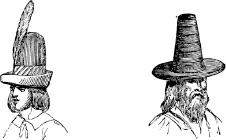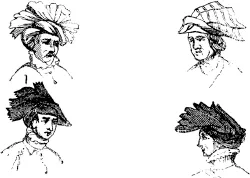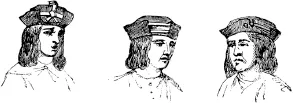![]()
PATENT REVERSIBLE
SHOOTING, FISHING, AND
TRAVELLING HAT.
Fig. 1.
Fig.2.
The hat or cap, for the principle is alike available, answers for shooting, fishing, or travelling, in all seasons, with a momentary protection from any amount of wet—a quality peculiarly to be desired in this changeable climate.
On this occasion I had the pleasure of finding a spontaneous welcome given to my invention by that able judge of all that is gentlemanly and sportsmanlike, the Field:—
“Mr. Melton, of 194, Regent Street, has patented a new hat, which combines all the requisites for a travelling-cap, a cool and porous head-cover on a hot day, and a waterproof one in wet weather. These several purposes are effected in a very novel yet simple manner, which will perhaps be understood by examining the accompanying illustrations. Fig. 1 shows the hat as in use in dry weather—made of cloth or tweed, and ventilating; and it will be observed that there is a double rim at the edge of the back brim. In the event of rain coming on, this upper rim may be reversed, and when brought over to the front, the hat is completely covered with a japanned waterproofing. Fig. 2 shows the waterproof cover about three-parts turned, so that the reversible portion may be seen. For hunting, shooting, fishing, driving, and a variety of purposes, nothing can be better, and it is not too much to say that it deserves to become a favourite with all persons who are much out in the open air; and we heartily wish the patentee of this ingenious invention the commercial success which he deserves.”
The spell once broken of the general hesitation on the part of exalted English gentlemen to commence wearing a novelty, has given rise to a very great change in the shape of felt hats, as suggested by His Royal Highness.
The round-crowned hats, so much in vogue lately, having become somewhat common, His Royal Highness proposed the hat as shown by the next drawing, and requested me to make three or four, covered with the same plaid, as his various shooting-dresses. Nothing could exceed their success; indeed, one made in a small check shepherd’s plaid, was perfection in taste.
The shape is now much patronized, and is a decided improvement upon the round-crown, being cooler to the head and admitting of better ventilation.
Few topics have been more discussed of late years than the existing cylindrical form of the hat, invariably reviled as most ugly. In that particular I venture to differ; at all events, to maintain that it is most suitable to the present mode of dress. Who shall say that an English gentleman of the present day is not the picture of manliness, comfort, and freedom from excess in his costume?
But to return to the question of the shape and mould of modern hats.
This hat, I may be told by our artist friends, is not picturesque; but is picturesqueness the only object aimed at in dress? Has not what was picturesque been gradually left off for what is easy and more comfortable? Why do fashions change? and what causes change? Some point of utility as well as elegance. An empress, gifted with the use of her limbs, possessing, moreover, natural tastes, and a fine free spirit for pure enjoyment, takes to walking in rocky paths through woods and over meadows, or upon plashy sands along a seashore. Forthwith, all female dress becomes succinct, and strong boots and a well-set stocking, and petticoats of warm material, become the fashion; bright colours being chosen in accordance with the Basque locality. Dresses must be held out, and up, not bagging or clinging to the wearer in the breezy walk. Hence the whalebone hoop, and thence—
To fifty chosen smiths, of special note,
We trust the important charge—the petticoat.
Pope, by the by, wrote sylphs, but another reading will better suit the steel-woven crinoline. Do men hide their faces in beards, and so conceal all the expression, and lose the play of the mouth and chin, for picturesqueness? No!—but for convenience, health, and comfort. Soap and water, and shaving tackle, with other toilet gear, were scarce, and sore throats plentiful, in our Crimean campaign; so men left off shaving perforce, and came home with beards; and the world of stay-at-home fashion saw that it was good.
Pelo, pelo! pelo e non pelle,
Per far fortuna ed inamorar le belle.
Beard! beard and whisker, boy, your stock-in-trade is,
Fortune to win, and conquer all the ladies.
The hard cylinder and the funnel hat, unpicturesque as artistic gentlemen deem them, have their uses and convenience. The Earl of Harrington had a habit, as I have heard, of trying his hats by standing on them! I was surprised, on first learning the whim of this leader of fashion, at such an apparently gay experiment, which his lordship performed, as I was told, with a solemn gravity. I was, however, compelled to recognise this as an evidence of judgment and not of eccentricity. A hard hat had once saved his head in the hunting-field. Up to that time, the run had been upon beaver hats only, and the silk or “shining hat” was despised as a vulgar, cheap excuse, a “sham,” only fit for postboys. Beaver hats, however, soon declined in fashion, in consequence of losing colour and richness, by cutting down to a short nap the points and best parts of the fur; and the French hat, as it was then called, displaced the fluffy beaver. We meet the long rabbit’s fur imitation of it occasionally at a country fair in company with a red-striped waistcoat; but, unless in the brighter days of the warm opening of autumn, the beaver has disappeared from the heads of the haut ton.
The late Earl of Harrington was a little in advance of my time, although living and retaining his original style of hats. He was one of the most eccentric men of his day, and more eccentric indeed, to my mind, than became a man of taste. His test of the quality of his hats, by standing upon them, was a liberty the hats could meet without a dent, as their weight was never less than 20½ ounces. These hats were always of the finest quality of beaver, and £3. 3s. each. The Earl was peculiarly sensitive upon the colour of his hats, and his eccentricity led him to adapt his taste in that particular to the object he had in view. When walking in his garden he would wear a sage-green hat, so as not to frighten the birds!
The “funnel” shaped hats are the finest ventilators known, combining at the same time shelter and protection. Reflection will make us confess, that these shapes of our hats are the result of, and concomitant with, the natural growth of the progress of civilization and the exigencies of social life. They constitute an important portion of the natural fitness of things. They are the harmonious completion of a system of cravats, shirts, waistcoats, coats, and trousers, each made for the other, and severally parts to a whole. Our friend in the black coat and grey trousers would look like a gilt dustman, if he crowned his toilet with the hat and feathers of King Charles’s or King Louis XIV.’s time, as here set forth.
He who has seen an assemblage of 50,000 Foresters at the Crystal Palace, with 10,000 Robin Hoods, each holding a child in one hand and a pot of beer in the other, or witnessed the comic appearance of a Highlander in a pea jacket (a phenomenon that startled the ladies’ gallery on the misty morning that preceded the opening of the last Great Exhibition,) can estimate the effect of a display of slashed doublets, russet boots, lace ruffles, and ribbons, accompanying a lawyer’s wig and bag along Chancery Lane!
I feel myself called upon to come to the rescue and to put on “the gloves” in defence of a knock-down blow lately given to the poor much vilified “hat” by one of the ablest writers of the day. It necessarily requires British pluck to stand up against such a powerful adversary.
I dare do all that may become a man;
Who dares do more is none.
The hat, in a recent number of All the Year Round, is CRUSHED thus:—
“But what Fiji would wear our black hat? What aboriginal would not dance on it in sheer disgustful contempt! It is costly, frail, lets in the rain, does not keep out the sun, attracts the wind, is unfit to travel or to sleep in, is ugly, uncomfortable, cold; yet it has existed now in full fashion for some seventy years, ever since the First Consul’s time in fact, and it defies all reformation. Stupid type of Chinese changelessness that it is. It has spread over all Europe, and reigns predominant wherever civilization is.”
In the first place, I must distinctly maintain that the hat is not an expensive article; it costs in a year less than any other part of one’s dress. Its frailty is quite a matter of option, as it can be made so light as to weigh only 2½ oz., or pretty nearly as strong as oak. It does not let in the rain; it does keep the sun from the head; and, when made a fair width in the brim, protects the eyes from the sun. That it may attract the wind I admit, but that is counterbalanced by the fact of its affording the means of effecting perfect ventilation—which hats of the present day can be arranged to do, so as to defy any fault-finding upon that important point. That it is not the multum in parvo desired by our distinguished author, having in itself every requisite—such as to travel or sleep in,—I admit. Perhaps the distinguished critic would like it to comhine the advantage of a bootjack? Cold it cannot be; and as to its being uncomfortable, that can only arise from carelessness in the fit; while, to my mind, the fact of its universal adoption is a good proof of its general merits. I am constantly subject to the simple remark of “Why do you not introduce something new to replace the present hat?” But when I have opened upon the subject, the inquirer has lost all argument, and admitted that he dislikes the hat because other persons have expressed similar objections. In no instance have I received anything like a sound suggestion for improvements.
I am told that the hat is not picturesque. Neither ought it to be for an Englishman, dressing as he does. I remember Mr. James Wallack looking very handsome in the “brigand” hat the picturesque hat suited to the dress of that elegant, but by no means respectable character. Would such a hat do for the practical comfort of our costume? Let me ask any man if he has not now and then seen in the streets of London an occasional hat-hater, who has gone in for a dash at “Rembrandt” with a hat—a slouch felt hat—looking a perfect guy for his prejudice and attempt at the picturesque?
How few of our modern innovators would desire to change even the much abused “chimney-pot” for the princely foolscaps of the 12th century—
Or those, “of a bright yellow colour, and ornamented with blue trimmings,” of Edward IV.’s time—
Or those folded napkins of the 15th century—
surely the ugliest head-gear ever invented! Or the blue-coat-boys’ muffin cap of Edward VI.; or those “flatheads” and half-muffin caps of the 16th century—
They must have been the “buttoned bonnets” mentioned at an earlier date by Chaucer—
“His stature was not very tall;
Lean he was; his legs were small,
Hose’d with a stocken red;
A buttoned bonnet on his head.”
In the same century commenced the struggle between hats, then of beaver, and caps, that ultimately terminated in the victory of the blocked hats. These, from their greater comfort and better adaptation to the requirements of the climate, kept triumphant possession of the field, in various modified shapes, for three entire centuries, until much foreign travel, an influx of Highland shooting, and a general loosening of costume, owing to the pulling habits of the Oxford and Cambridge boat-racing, brought into use again the comic expansion of the billycock (the ancient pileus), the navvy’s “wideawake” (in reality so called, as I am told, because it had never had a nap), the petasus of the ancients, an expansion of the pileus; the boating-hat of straw; the “turban,” or “pork-pie;” the fishing-cap, with solid brim and flexible brain-case, and finally, the close-fitting round felt hat, which was a repetition of the accompanying example of the 12th century taken from a manuscript in the Cambridge Library, and of which, as I have before had occasion to ment...








